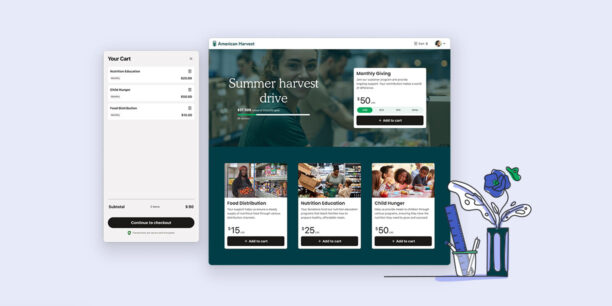What Is Crowdfunding and How Does It Work?

Request a Demo
Learn how top nonprofits use Classy to power their fundraising.
Crowdfunding is the practice of raising small amounts of money from a large number of people. The money raised typically funds a specific project, goes toward general donations, or drives support for a time-based initiative.
As the saying goes, small things, done consistently, can add up to big things over time.
While crowdfunding campaigns and peer-to-peer fundraising are centered around raising money to achieve a funding goal, the primary difference is how the funds are solicited. The main call to action for a crowdfunding initiative is to donate. The purpose of peer-to-peer fundraising is to call supporters to fundraise on behalf of an organization, typically through online platforms.
The Benefits and Challenges of Crowdfunding
Crowdfunding has become a popular method for entrepreneurs, nonprofits, artists, and individuals to raise capital and support for their projects.
One significant benefit is its ability to democratize access to funding. It allows people and organizations to reach a broader audience, tapping into a pool of potential backers who are willing to support innovative ideas or projects. Crowdfunding platforms also serve as a marketing tool, enabling project creators to showcase their ideas, build a community around their work, and gain valuable feedback. Successful campaigns help validate and refine ideas as well.
However, crowdfunding also comes with its own set of challenges. One of the primary drawbacks is the high level of competition. With numerous campaigns running simultaneously on platforms, standing out from the crowd and gaining visibility can be difficult.
Additionally, there’s no guarantee of success; some projects might not reach their funding goals, leading to wasted time and effort. Fulfilling promises to backers can also be demanding; creators may face challenges in meeting deadlines, managing expectations, and delivering on their commitments, leading to potential reputational damage if things don’t go as planned.
While crowdfunding offers an excellent opportunity for funding and community engagement, it also demands careful planning, marketing effort, and the ability to deliver on promises to maintain trust and credibility.
How Crowdfunding Works
Crowdfunding is a team effort. It can help a startup get off the ground, provide small business owners with enough funding to open their doors, or support nonprofit relief efforts when disaster strikes.
In general, successful crowdfunding campaigns are composed of four steps:
- Platform Selection
- Platform Acceptance
- The Pitch
- Receiving Payout
It’s important that your target audience remains at the center of each decision throughout these four steps. Regardless of your goal, the key to crowdfunding success is engaging the right people in meaningful ways.
Start by identifying who you’re talking to. From there, craft your strategy to align with those supporters’ preferences, tendencies, and behaviors.
Selecting a Crowdfunding Platform
When it comes time to choose a crowdfunding platform, the process can be overwhelming. We’ve broken it down into three simple recommendations.
Evaluate the Fundraising Platform’s Pricing and Fee Structure
- Credit processing fees. A small percentage of each monetary gift to a crowdfunding campaign goes to the online platform that hosts the campaign’s processing service. That fee covers transmitting the data, authorizing the transaction, and depositing the funds. Look for a site that offers benefactors the choice to cover the processing fees to avoid missing out on impactful fundraising dollars.
- Percentage platform fees. While the percentage taken in processing fees can vary from platform to platform, it’s important to know that they are often calculated and deducted from the total amount of money you raise. This is how platforms make most of their revenue. Carefully consider how this deduction from your funds could impact your fundraising goal.
Investigate Ease of Use and Customization Options
- Ease of use. Time is our most valuable asset. Make sure you’re looking for a fundraising platform that keeps things simple. The less time you spend building, updating, and optimizing your crowdfunding campaign page, the more time you have to raise money.
- Customization options. Consistent branding on your crowdfunding campaign helps create an identity for your organization. It shows who you are, what you stand for, and how this crowdfunding initiative will help sustain your good work. Advanced customization options allow you to easily communicate your values, clarify your call to action, and tell your nonprofit brand story that resonates with anyone who visits your donation website.
Identify Available Resources and Customer Service Offerings
- Accessible resources. The key to success is having the right tools. Explore each potential fundraising platform’s site to look for online tutorials, resource guides, or even a list of up-to-date FAQs. These easily accessible resources can be a major source of time savings throughout your crowdfunding campaign.
- Attentive customer service. If you run into a problem in the creation or launch phase of your crowdfunding campaign, you’ll want the comfort of knowing that someone is there to help. Try contacting customer support before you select a fundraising platform to ensure their support team is both helpful and responsive.
Getting Accepted by a Fundraising Platform
While this isn’t always the case, certain platforms may require you to fill out online forms and provide documentation before being accepted to host your crowdfunding campaign on their site. This process ensures you’ve met the platform’s creator requirements and will use it as intended.
Requirements vary from platform to platform, but here are a few examples:
- You are 18 years of age or older
- You are a permanent resident of one of the eligible countries
- You have an address, bank account, and government-issued ID based in the country you’re creating the project in
- The linked bank account belongs to the person who verified their identity for your project
- You have a major credit or debit card
The Pitch
Once a fundraising platform accepts you, you’ll be asked to pitch your project to their team to ensure it’s a good fit. What are you trying to accomplish? How much are you hoping to raise? How do you plan to solicit support?
Prepare for this pitch by proactively identifying your campaign narrative and laying out your nonprofit marketing plan. Think of the pitch similarly to promoting your organization through word of mouth, social media, and paid ads. It’s your opportunity to sell your story and garner support from donors, accredited investors, family members, or others who feel passionate about your initiative.
Receiving Payout from Your Crowdfunding Campaign
This is where all of the research you did before selecting your crowdfunding platform comes into play. Some platforms will payout all the money you raised during your campaign regardless of the final total, while others may only offer a payout if you hit your fundraising goal. The pricing and fee structure also play a large part in the percentage of funds that will land in your organization’s bank account once the campaign wraps.
With the ultimate goal of raising as much money as possible, be sure the platform you select doesn’t have any fine print that could interfere with your success.
Crowdfunding Types
Crowdfunding is used most commonly by startup companies or growing businesses, as well as nonprofit organizations raising money for worthy causes. Although these organizations are all working toward the same result, the different types of crowdfunding they’re applying are different. Below, we break them down to help you understand which applies to your organization.
Rewards-Based and Equity-Based Crowdfunding
When someone contributes funds in exchange for something, it falls into the rewards-based crowdfunding bucket. This is typical for startups that might offer free swag or a discounted service. Similarly, equity-based crowdfunding, or equity crowdfunding, allows small businesses and startups to give away a portion of their business in exchange for funding.
Donation-Based Crowdfunding
The simplest type of crowdfunding is donation-based crowdfunding, which means someone gives money for nothing in return. While seemingly lackluster for the donor, this crowdfunding type can be extremely rewarding. It attracts loyal supporters who are passionate about your work, which we see happen year after year across the social sector.
Crowdfunding Use Cases
Depending on your unique goal, how you conduct a crowdfunding campaign may differ. Below we break down the most common applications of crowdfunding and how to successfully bring each strategy to your organization.
Philanthropy
Demonstrated by global giving initiatives like Giving Tuesday, crowdfunding has proven its impact on the long-term health and sustainability of nonprofits worldwide.
A crowdfunding campaign is built to inspire support for your cause with a robust narrative that ultimately drives people to make a gift. It consists of a campaign landing page highlighting your impact to draw people in and a donation form to simplify the transaction process.
Crowdfunding campaigns are a great way to create a sense of urgency with your target audience and motivate immediate action. A few common nonprofit crowdfunding applications include:
- General donation fund
- Time-bound project
- Disaster relief
Science
Crowdfunding supports impactful scientific research that may be impossible otherwise. Capturing the interest and backing of thousands of individuals willing to donate can significantly change the way science evolves in the future.
Researchers pitch a proposal to garner support through a crowdfunding page. Patients, medical professionals, and individuals with a strong belief in a specific area of science can contribute to the project by simply donating online. Broad support allows for greater intellectual freedom and independence and provides scientists with an opportunity to build credibility.
Just look at the Gray family, devastated by their young daughters’ 2015 diagnosis of the fatal and incurable Batten Disease. They turned to crowdfunding to accelerate research in three promising treatment options.
With $1 million dollars, the family would be able to hire a team of doctors and scientists committed to researching to treat the rare disease. Since its start, they have raised $2.6 million and counting and have started FDA filings for a clinical trial.
Startups
Rather than depending on traditional funding sources, startups can capitalize on the support of friends, family members, entrepreneurs, and potential investors to get their businesses off the ground.
Crowdfunding makes it easier for startups to amass capital and market their new business to larger audiences. Investors want to see a company do well when their finances are involved. That usually makes them eager to spread the word about the new products and initiatives you’re working on.
These organic conversations lead to greater brand awareness, which could motivate other investors to get on board or encourage future customers to purchase your products or services.
Startups typically offer investors something in return, most commonly through rewards-based or equity-based crowdfunding. They use social media and crowdfunding websites to educate both primary and extended networks about the opportunity to fund an emerging business. Doing so highlights the perks and incentives people will receive in exchange for support.
Oculus, the wildly popular virtual reality headset, started on a crowdfunding site. Within four hours of launching the campaign, they achieved their goal of $250,000 and went on to raise $2.4 million.
Crowdfunding Websites
When you’re looking for people to help fund a new project or business venture, it’s critical that the transaction process is as seamless as possible. Social media is a great place to raise awareness, but finding the right fundraising platform to convert supporters into donors or investors is critical.
Below we’ll break down the best crowdfunding sites to help you understand what makes each site unique.
Classy.org
Made for nonprofits, Classy’s crowdfunding platform allows charitable organizations to create evergreen microsites that simplify the donation experience and maximize conversions.
Easily customize campaigns with a complete set of advanced design tools to communicate a clear mission. Offer flexible payment options, manage online donor activity with ease, and take the stress out of the tax preparation process with Classy.
GoFundMe
Best for personal fundraising, GoFundMe is a versatile platform that helps individuals raise money for everything from medical needs to emergency response.
The GoFundMe platform makes it simple for families and communities to receive the funds they need to get back on their feet quickly.
Complete with a 0% platform fee, this site can help individuals reach their fundraising goals by offering support in trying times.
Indiegogo
If you’re looking to launch a new idea or product, Indiegogo offers the tools to set up a 60-day campaign to help raise funds and garner support. By giving entrepreneurs a platform to introduce clever or unconventional products to the world, this site fuels innovation.
Indiegogo’s crowdfunding campaigns allow entrepreneurs to get curious and creative and provide early backers and angel investors a place to discover groundbreaking products before they hit mainstream availability.
KickStarter
Kickstarter is a place for creatives to share their visions with communities that will support them. No matter how big or small, the platform wants to help creators of all kinds, including filmmakers, artists, musicians, designers, and more. They can easily spread the word about their new projects and welcome backers to become part of the magic.
Common Crowdfunding Questions
How much money can you make through crowdfunding?
The revenue a crowdfunding campaign will generate varies from hundreds to millions of dollars depending on multiple factors.
On average, crowdfunding campaigns that successfully reached their goals raised $28,656 with an average pledge of $96. When we look at all crowdfunding campaigns, rather than just successful campaigns, the average raised is $824 with a pledge size of $88.
Crowdfunding is projected to grow by $300 billion by 2030, so we can expect that these averages will continue to fluctuate.¹
Believe it or not, America’s first major crowdfunding project dates back to the summer of 1885 when the Statue of Liberty was shipped in pieces from France, awaiting assembly. Americans could not raise the $250,000 they needed for a granite base for the statue until the launch of a fundraising campaign in The New York World newspaper.²
What’s the difference between peer-to-peer and crowdfunding?
The primary difference between crowdfunding vs. peer-to-peer fundraising is the call to action.
Crowdfunding campaigns are versatile appeals for support with the main call to action to donate. A peer-to-peer campaign invites supporters to fundraise on behalf of your organization to reach a larger audience.
Both include the option to complete a one-time donation, but the goal of a peer-to-peer page is to recruit individuals who will appeal to their personal networks.
How do crowdfunding campaigns work?
Crowdfunding is raising money from many people to fund a project, new business venture, product launch, or worthy cause. Crowdfunding campaigns are typically conducted online through a fundraising site and intended to garner support to achieve a set fundraising goal. These crowdfunding examples do a great job of laying it out.
How do I tell a good story for a crowdfunding campaign?
Nonprofit storytelling is a huge part of creating meaningful connections with supporters. Rather than simply informing people about why your campaign is important, create a felt experience with sensory, descriptive language.
Keep your text short and include compelling imagery, like photos or videos. Clarify the tangible impact of each contribution and focus on one clear call to action that will drive conversions.
Ready to Start Crowdfunding?
Crowdfunding is a central fundraising model worldwide. These campaigns serve as both a tool to bring personal projects to life and a powerful way for impactful organizations, creators, and businesses to share their stories. It can help fund programmatic and operational initiatives with the support of an extended network.
Tell your nonprofit story and inspire support for your cause with Classy’s conversion-optimized crowdfunding platform and give your mission the recognition it deserves.
Article Sources:
- “Crowdfunding Statistics: Market Size and Growth,” Resources, Fundera, last updated January 23, 2023, https://www.fundera.com/resources/crowdfunding-statistics.
- “The Statue of Liberty and America’s Crowdfunding Pioneer,” News, BBC, last updated April 25, 2023, https://www.bbc.com/news/magazine-21932675.
Posted in Fundraising Crowdfunding

Crowdfunding Campaigns in Minutes
Subscribe to the Classy Blog
Get the latest fundraising tips, trends, and ideas in your inbox.
Thank you for subscribing
You signed up for emails from Classy
Request a Demo
Learn how top nonprofits use Classy to power their fundraising.
 Explore Classy.org
Explore Classy.org 

